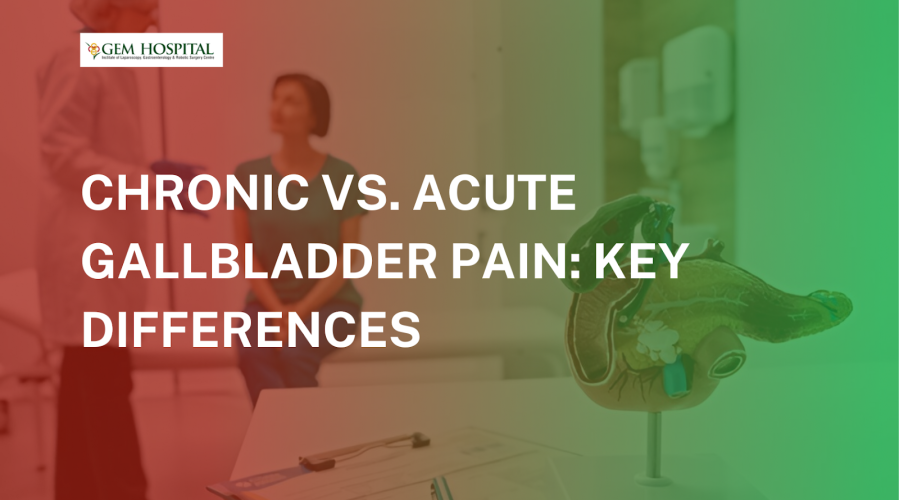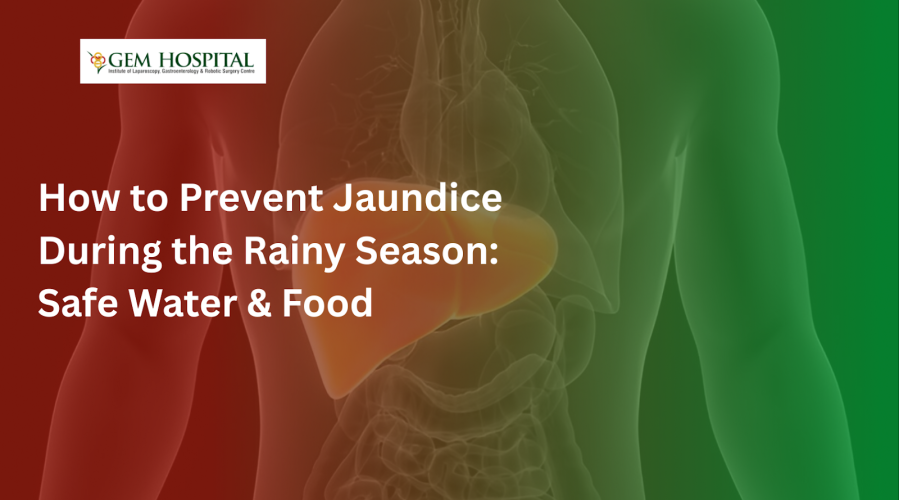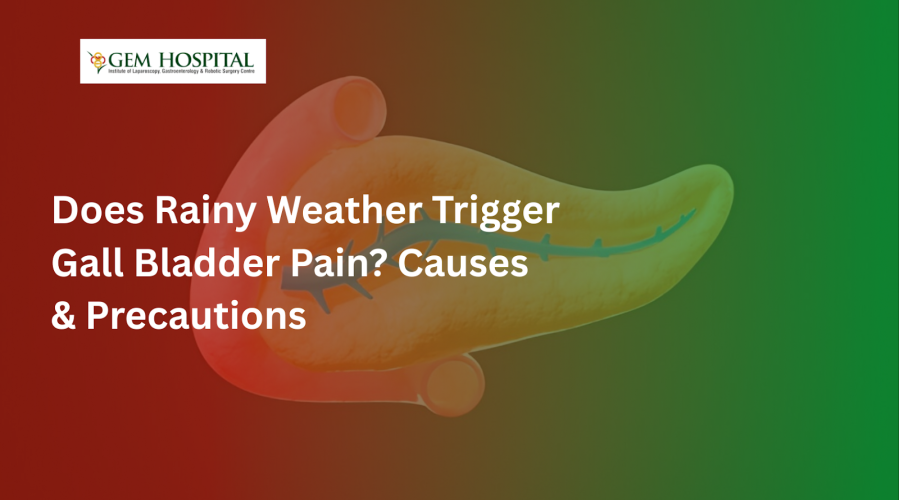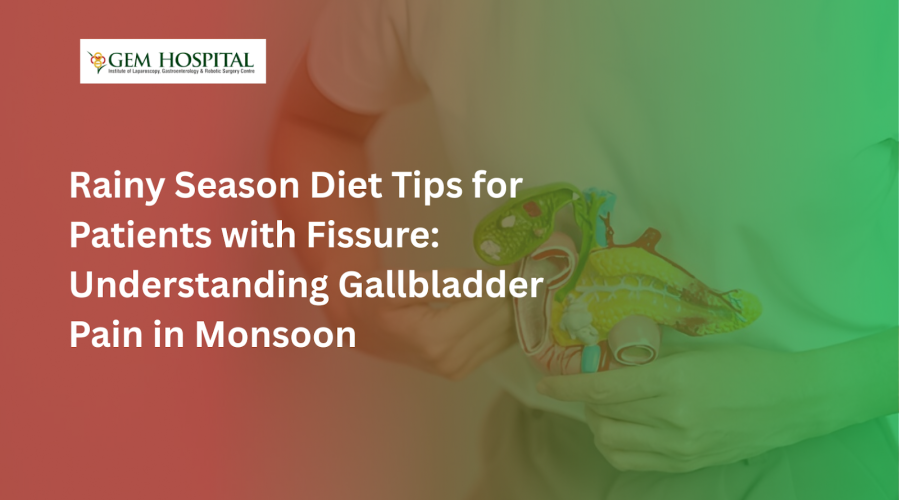Learn how to prevent jaundice during the rainy season with simple safe water practices and healthy food habits. Discover key hygiene measures, diet precautions, and monsoon safety tips to protect your liver and overall health.
Chronic vs. Acute Gallbladder Pain: What You Should Know

The gallbladder is a small organ located under the liver. It is critical to digestion because it stores bile, a fluid involved in the breakdown of fats. Though most people never have a problem with their gallbladder, some people do develop conditions that lead to Gallbladder pain and discomfort. Gallbladder pain may be acute (sudden and severe) or chronic (long-term and recurring). Knowing the difference between the two is important for getting the correct treatment and avoiding complications.
In this article, you will learn about acute versus chronic gallbladder pain, their causes, symptoms, treatment options, and when to visit the doctor.
What Is Gallbladder Pain?
Gallbladder pain typically happens in the upper right side of the abdomen, just below the ribs. It can also radiate to the back or right shoulder. This type of pain is usually caused by gallstones, as well as inflammation or infections of the gallbladder or bile ducts.
Gallbladder pain can be constant or intermittent, mild to severe. Some individuals have sudden, severe bouts, while others have low-grade but frequent discomfort over time. Let’s take a closer look at the two major categories: acute and chronic gallbladder pain.
Acute Gallbladder Pain
What Is It?
Acute gallbladder pain is sudden, severe and intolerable. It is something that is indicative of an underlying condition, typically a more serious condition that requires medical evaluation and treatment in an appropriate timeframe. Untreated, acute gallbladder problems can result in dangerous complications including infections, tissue damage and bile duct blockages.
Symptoms of Acute Gallbladder Pain
- Sudden, sharp pain in the upper right abdomen
- Pain that worsens after eating, especially fatty foods
- Nausea and vomiting
- Fever and chills
- Yellowing of the skin and eyes (jaundice)
- Tenderness when pressing the abdomen
Causes of Acute Gallbladder Pain
Several conditions can trigger acute gallbladder pain:
- Gallstones – Small, hardened deposits of bile that can become lodged in the bile ducts and slow or stop the flow of bile.
- Cholecystitis – Inflammation of the gallbladder, often due to gallstones or infections.
- Bile Duct Blockages – When gallstones or thickened bile (bile sludge) block the bile ducts, causing pain and swelling.
- Infections – Gallbladder pain, severe fever, etc. can be caused due to bacterial infections.
Treatment for Acute Gallbladder Pain
Because acute pain is often a medical emergency, treatment may involve:
- Pain relief – Medications to reduce discomfort and inflammation.
- Antibiotics – If an infection is present, doctors may prescribe antibiotics to prevent complications.
- IV Fluids – To keep the body hydrated and reduce inflammation.
- Surgery (Cholecystectomy) – In many cases, gallbladder removal surgery is recommended to prevent future attacks and complications.
Chronic Gallbladder Pain
What Is It?
Chronic gallbladder pain is typically less intense than acute pain, but it lasts longer and may come and go over time. People with chronic gallbladder issues may experience frequent discomfort, bloating, and digestive problems after meals.
Symptoms of Chronic Gallbladder Pain
- A dull or aching pain in the upper right abdomen
- Pain that lasts for hours or days but is not severe
- Bloating and indigestion, especially after eating fatty foods
- Nausea and occasional vomiting
- Frequent burping and gas
- Mild discomfort that comes and goes over weeks or months
Causes of Chronic Gallbladder Pain
- Chronic Cholecystitis – Long-term inflammation due to repeated gallstone attacks or poor bile drainage.
- Gallbladder Dysfunction – When the gallbladder does not empty properly, leading to irritation and discomfort.
- Bile Sludge Buildup – Thickened bile can accumulate in the gallbladder, slowing digestion and causing irritation.
- Scarring and Damage – Repeated gallbladder attacks can cause permanent damage, leading to ongoing pain and poor function.
Treatment for Chronic Gallbladder Pain
Treatment for chronic gallbladder pain depends on the severity of symptoms:
- Dietary Changes – Avoiding fatty, fried, and processed foods can reduce symptoms and improve digestion.
- Medication – Doctors may prescribe bile salt supplements to help break down gallstones and improve bile flow.
- Lifestyle Adjustments – Maintaining a healthy weight, eating smaller meals, and staying hydrated can support gallbladder health.
- Surgery (Cholecystectomy) – If symptoms worsen or interfere with daily life, gallbladder removal surgery may be necessary.
When to See a Doctor?
Gallbladder pain should never be ignored. Seek medical attention immediately if you experience:
- Severe abdominal pain that does not go away
- High fever, chills, or signs of infection
- Jaundice (yellowing of the skin and eyes)
- Vomiting that does not stop
- Pain that interferes with daily life
Untreated gallbladder issues can become serious, leading to infections, bile duct blockages, and liver or pancreas damage. Preventive health measures such as early diagnosis and Gallbladder treatment can help avoid serious damage.
Get Expert Care at GEM Hospital
GEM Hospital is available to help you if you are experiencing chronic or acute gallbladder pain. Our experts offer cutting-edge diagnosis and customized protocols to alleviate your suffering and restore your well-being.
Schedule an appointment today! The Right Care for Gallbladder Health.
Blogs & Article
Understand why rainy weather may trigger gall bladder pain. Explore the causes, symptoms, and essential precautions to manage discomfort during monsoon season. Learn how humidity, diet changes, and infections influence gallbladder health.
Discover essential rainy season diet tips for patients with fissures and understand why gallbladder pain increases during the monsoon. Learn what foods to avoid, what to include, and how to maintain digestive health in humid weather.


